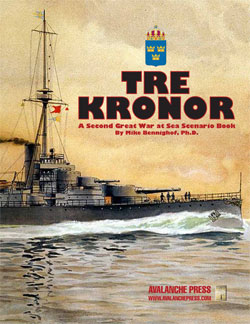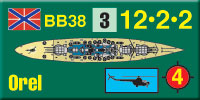Tre Kronor:
Russian Battleships
by Mike Bennighof, Ph.D.
April 2020
 In our Second World War at Sea games, as in the actual Second World War at sea, combat between battleships is unusual, and even more unusual are battles with more than one battleship on each side. That’s due in part to the dominance of air power, and in part due to the relative scarcity of battleships thanks to naval limitations treaties. In our Second World War at Sea games, as in the actual Second World War at sea, combat between battleships is unusual, and even more unusual are battles with more than one battleship on each side. That’s due in part to the dominance of air power, and in part due to the relative scarcity of battleships thanks to naval limitations treaties.
For our alternative-history Second Great War at Sea story arc, I wanted lots of battleship action. And so there are lots of battleships in the mix, with much more relaxed limitations treaties, and air power is not nearly so potent.
That’s even more important in Second Great War at Sea: Tre Kronor, an expansion for Sea of Iron where the action takes places on the Baltic Sea. The Baltic Sea isn’t very big, and the fleets can’t very well hide from one another. They also can’t hide from enemy airplanes, and that limits the surface battles of Sea of Iron, since that game’s limited to things that really happened.
Tre Kronor lets us play with the big ships. Let’s look at the set’s new Russian battleships.
The Mighty Dreadnought

In 1914 Baltic Fleet commander Nikolai von Essen asked international arms dealer and man of mystery (and Vickers board member) Basil Zaharoff to provide plans for new dreadnoughts that could be built in Russia or Britain. Essen specified that he wanted complete designs, knowing that these would likely have been offered to other navies already but not wanting to lose time in the drafting process. Zaharoff responded with six proposals.
The most powerful of them, Vickers Design 651, had originally been prepared for Japan despite its great resemblance to Russian dreadnought practice. The flush-decked ship came in at 30,750 tons, with two funnels and a top speed of 25 knots.
She carried eight 16-inch 45-caliber guns in four twin turrets, all on the main deck level. Vickers designed the guns in 1914 for the Russians, and completed a prototype in 1917 that underwent firing trials despite the impossibility of the order ever being fulfilled. Despite the Cuniberti-style deck and armament layout, the hull form and the rest of the armament closely followed Sir George Thurston’s design for the Japanese battle cruiser Kongo, with sixteen 6-inch guns in casemates mounted in the hull and eight hull-mounted torpedo tubes.
This ship would never be ordered, let alone laid down, but in our alternative history she’s approved in 1914 but not laid down until 1917, just after the peace negotiated by Woodrow Wilson ends the Great War. Two of them are laid down in St. Petersburg shipyards, providing well-paid work for angry, restless shipfitters and returning soldiers.
Narva and her sister Lesnoye commissioned in 1922 for the Baltic Fleet, and formed the fleet’s core for the next decade. Between 1935 and 1937 they underwent extensive reconstruction along the same lines as the Borodino class battle cruisers. B turret (the second from the bow) was removed and the barbette of C turret (third from the bow) built up to allow it to fire directly after over D turret, with all of the deck structures between them removed. In addition, they received improved turbines, better deck armor and underwater protection, and new electronics. They lost their torpedo tubes and had their casemate-mounted secondary battery replaced with dual-purpose 130mm guns on the main deck.
While now sporting fewer big guns than they had as built, the two ships had become reasonably effective if lightly-armed fast battleships. Scheduled for deployment to the Pacific after the first two ships of the new Rossiya class commissioned, they were still in the Baltic when Russia launched the Second Great War.
The Italian Job

During the 1930’s, the Soviet Union turned to Italian shipyards for assistance in learning the most modern techniques of heavy warship design. Revolution, Civil War and a generally paranoid outlook had isolated Soviet naval architects from current practice.
In the world of the Second Great War, there is no Soviet Union, but Imperial Russia has undergone a fair amount of social and economic disruption. Russian ship design has fallen behind that of the West, and Imperial Russia’s first new class of battleships is based on a leftover Great War-era design. The Retvisan class boasted great size, but weak protection and poor layout of her impressive armament.
Seeking to vault into the first rank of naval powers, the Russians (like their Soviet counterparts in the world we know) turned to Italy for new warship designs. The new Italian battleship Littorio, considered the cutting edge of battleship design, became the basis for a new class of Russian fast battleships.
Russian shipyards laid down the first ships in 1929, even before the Royal Italian Navy began construction of its own units, and would eventually lay down ten ships to this design. The Russians made some alterations to the Littorio design, accepting slightly less speed in exchange for greater range, but outwardly the Italian and Russian ships looked very similar.
Nominally displacing 35,000 tons, the ships weighed in at about 41,000; the Russians kept the Italian open secret and also claimed a displacement of 35,000 tons. The new Russian battleships carried nine 15-inch (380mm) guns, a dozen six-inch (152mm) secondary guns and an array of lighter anti-aircraft weapons, and could make just under 30 knots. They operate six helicopters off their fantail, with a small hangar deck below it.
Note: The Soviet Union purchased the plans for Littorio and planned their own version, much as described above although we’ve moved the initial date of the design’s completion forward by a couple of years. The Soviets may not have realized, and certainly did not care, that the ships would have displaced much more than advertised. Initial Italian plans for the class actually called for them to operate six autogyros off the fantail. Before construction began this was altered to a conventional arrangement of a catapult for seaplanes which would remain stowed on the deck.
The Royal Italian Navy accepted the 15-inch main caliber for the Littorio class, even though international naval limitations treaties allowed one of 16-inch. The Ansaldo combine’s OTO firm, which made Italy’s heavy guns, apparently could not produce a 16-inch gun but did provide an exceptionally fine 15-inch weapon. The Model 1934 had greater striking power than weapons of the same caliber, very good accuracy and greater range than any other battleship gun; on the negative side, it had a barrel life less than half that of most other heavy guns, requiring more frequent re-linings and replacements. The Italians happily accepted the weapon, but Russia’s Tsar Alexei bridled at the thought of building new battleships with smaller main guns than those of other nations’ battleships.
The Prestige Ship

Russia’s Obukhov Works had built the 16-inch Pattern 1914 guns for the huge Kostenko battleship design laid down in the 1920’s, and worked with designers from the OTO firm to enlarge their 15-inch gun to meet the Tsar’s demands. The resulting B-37 model 16-inch (406mm) matched the range and accuracy of the Italian 380mm Model 1934, but shared its problems of short service life and need for very finely-made ammunition to meet its performance parameters.
To mount the new gun, the Russians ordered eight more ships to a modified Littorio design, carrying eight rather than nine main guns. The hull was slightly enlarged to accommodate the larger turrets, and the super-firing “B” turret reduced to two guns rather than three to limit the weight increase of the heavier armament. The re-design added little to the ship’s fighting power at considerably more cost, but placated the Tsar, and therefore had to be considered a success.
Notes: Josef Stalin had similar complaints about the Littorio design, and the Bolshevik Plant (as the Obukhov works were re-named under the Soviet regime) designed the B-37 gun to meet his demands. The improved Littorio went through numerous re-designs and improvements until the final version, the huge battleship Sovietsky Soyuz, bore only a superficial resemblance to her Italian cousin. The Sviatoslav class in our Second Great War alternative history is based on one of the earlier proposals.
The Super-Battleship

Still displeased that other nations had more powerful battleships, with nine or ten 16-inch guns rather than the mere eight of the newest Russian ships, the Tsar demanded that his navy procure even larger and more powerful ships. The appearance of the new German battleship Deutschland at Kiel Week in 1937 enraged the young ruler; though he couldn’t travel himself, the color pictures sent back to St. Petersburg clearly showed that the new German battleship mounted ten heavy guns. Alexei wanted a new battleship that likewise carried ten main guns.
The Admiralty promptly cancelled the last two units of the Sviatoslav class and ordered a new design that met Alexei’s demands. Forced to rush their work, the tsar’s naval architects sketched an enlarged Sviatoslav, slightly lengthened with her after 152mm triple turret replaced by a twin turret for 406mm guns, super-firing over the aft triple turret. That gave her the desired armament of ten 406mm guns; bigger turbines allowed her to keep her top speed at 30 knots. Protection, range and helicopter capacity remained the same as the previous class. Building on a very solid design, the greatly enlarged Littorio proved a successful ship despite its origins.
The Russians laid down two ships in St. Petersburg in 1938, following with two more in Nikolayev 1939 and a third pair at Severomorsk in the early weeks of 1940. The first two were completed in 1941, with the war already raging, while construction on the second pair was suspended and the last two were dismantled on their slipways, with some of their frames assembled but the hulls nowhere close to launching.
And those are the modern Imperial Russian battleships found in Tre Kronor.
Don’t wait to put Second Great War at Sea: Tre Kronor on your game table! Join the Gold Club and find out how to get it before anyone else!
Sign up for our newsletter right here. Your info will never be sold or transferred; we'll just use it to update you on new games and new offers.
Mike Bennighof is president of Avalanche Press and holds a doctorate in history from Emory University. A Fulbright Scholar and award-winning journalist, he has published over 100 books, games and articles on historical subjects.
He lives in Birmingham, Alabama with his wife, three children and his dog, Leopold. Leopold fears helicopters.
|
